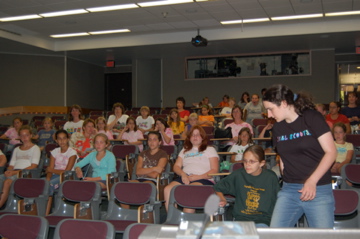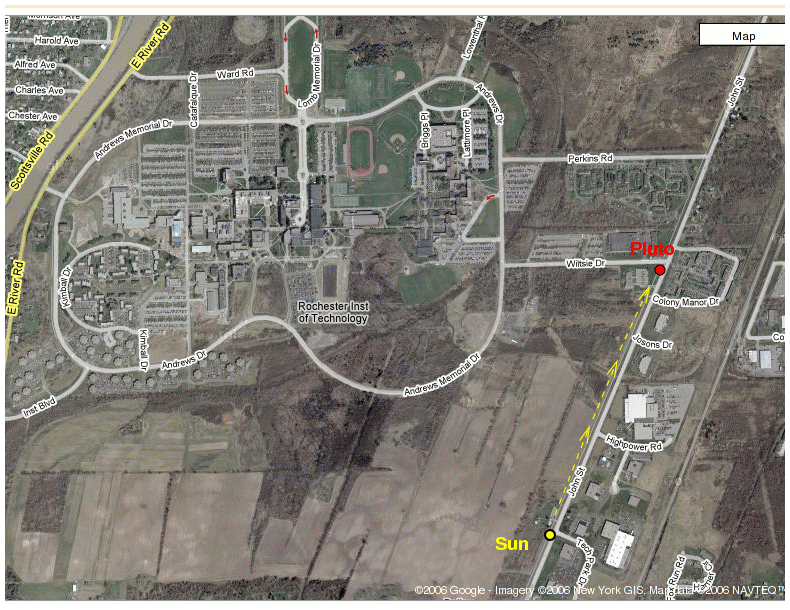
Click on this picture, and other pictures, for a larger version.
During the spring of 2006, one of the local Girl Scout leaders contacted Stefi Baum, the head of the Center of Imaging Sciences at RIT, to ask if RIT would be able to offer a program on astronomy (as well as imaging and other topics). Stefi -- a former Girl Scout -- agreed, and asked me to arrange an astronomy event. We settled on an "overnight astronomy camp" for the night of August 12/13, 2006, hoping that clear skies might reveal a few Perseids during our activities.
Many scouts signed up to come -- we reached our limit of 40 scouts well before the night itself. The weather was fair and things looked good. We met in the CIS building on the RIT campus at 7:00 PM. Since it wasn't dark yet, the scouts and their leaders watched a movie, Contact , in which a young girl grows up to become an astronomer and has some, um, interesting adventures.

Click on this picture, and other pictures, for a larger version.
When the movie finished, around 10:00 PM, we had a snack of pizza and soft drinks. We broke the scouts up into four groups of roughly 9 girls each.
Then everyone drove over to the RIT Observatory.
At the Observatory, we rotated the groups through four activities.
Preeti Kharb , a post-doc who studies active galaxies, taught the scouts about a few of the most prominent constellations. The girls also created their own figures from the patterns of stars. They then went outside to identify their constellations in the real sky.
Stacey Davis , a faculty member at NTID, led the scouts in making their own "star wheels": devices which show the location of stars visible for any given date and time. After a little practice inside, the scouts went outside to use their new wheels.
Dan Batcheldor , post-doc in CIS, and Tracy Davis, associate professor of Physics, set up several telescopes outside. The scouts looked at objects like the Moon with their naked eye, then through binoculars, and finally through a telescope. They drew pictures of each view.
Michael Richmond , associate professor of Physics, tried to give the scouts an idea of the sheer emptiness of space by having them create scale models of the planets, and then placing them at the appropriate distance from each other and a model Sun on the sidewalk outside the Observatory. Using a model in which Earth was a little bead about 2 millimeters in diameter, the distance between the Sun (a streetlamp) and Pluto (a very very small bead) was 939 meters! None of the scouts made it past Uranus ...

At around 12:45 AM, after all the groups had completed all four activities, the scouts returned to the Imaging Sciences building to sack out in several classrooms. It finally quieted down around 2:00 AM, and I hear some people actually managed to sleep.
Early the next morning, I put out the fixings for breakfast and made several pots of strong coffee. The scouts and their leaders gradually woke up, ate breakfast, filled out evaluation forms, and headed home.
Last modified 8/15/2006 by MWR